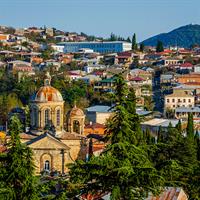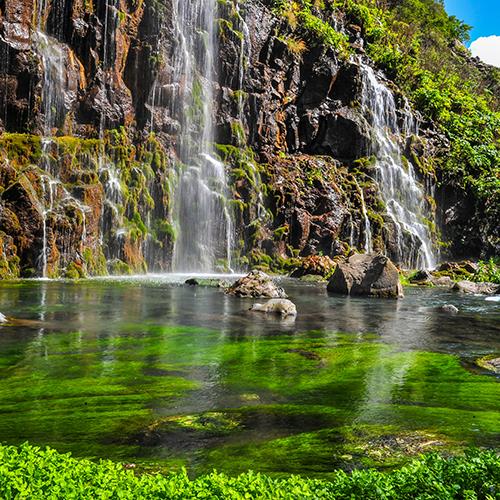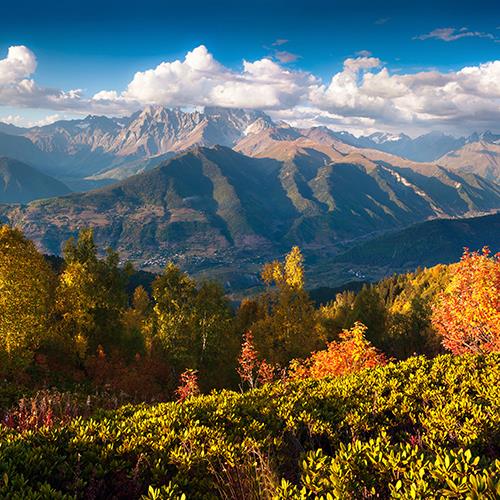Experience Kutaisi

Overview
Kutaisi is one of Georgia’s oldest cities and has been a historically significant city throughout the ages, even housing the parliament of Georgia at some point. Once the ancient capital of the Kingdom of Georgia in the 11th century, Kutaisi blends rich history with a relaxed, small-city vibe. It sits along the Rioni River, surrounded by rolling hills and lush countryside.
The city’s Old Town is filled with cobblestone streets, pastel-colored 19th-century buildings, lively markets, and charming cafés. Key highlights include the grand Bagrati Cathedral, perched on a hilltop with sweeping views; the Gelati Monastery, a UNESCO World Heritage Site; and the futuristic Parliament building, a symbol of Georgia’s post-Soviet transition. The White Bridge and Colchis Fountain are iconic spots in the city center and serve as popular gathering places.
Surprisingly, Kutaisi often gets overlooked by travelers who stick to Tbilisi before heading east to the wine region of Kakheti and Sighnaghi or venturing north to the mountains of Mestia or Kazbegi near the Russian border. But Kutaisi has plenty to offer for those who make the effort to visit. It’s a great place to spend a few days exploring historic sites and natural wonders, while also enjoying a slower pace of life in Georgia.



Things to see and do
Visit the Kvavila Monastery, perched on a hilltop overlooking the center of Kutaisi. It’s a modest church surrounded by a cemetery, also known as the “Green Flower” Church. It is a serene and historically rich site and offers panoramic views of the city and the surrounding landscape.
Discover the Bagrati Cathedral, Perched atop Ukimerion Hill. This Cathedral dominates the skyline of Kutaisi, and despite restoration controversies, it remains a testament to Georgian medieval architecture. Bagrati used to be a UNESCO World Heritage Site, but was removed from the list in 2017 because of the reconstruction.
Visit the UNESCO World Heritage Site of Gelati Monastery. Founded in 1106, and has served as a major center of education and culture in medieval Georgia.
Stroll through the Green Bazaar. This is Kutaisi’s main market, and a great way to experience local life, where vendors sell fresh produce, spices, and traditional Georgian products. Stroll around and chat with the locals, haggle for some fresh produce, and enjoy some local Georgian food.
Relax at the Kutaisi Botanical Garden. This is a peaceful retreat with a variety of plant species, ideal for a stroll or picnic.
Stroll Through the Old Town. Kutaisi’s city center is home to several impressive historical landmarks, including the Opera House, City Hall, the iconic White Bridge spanning the Rioni River, and the striking Golden Marquee. As you explore the charming streets, you’ll naturally come across many of these architectural gems. At the heart of the Old Town is the Colchis Fountain, an ornate centerpiece adorned with replicas of ancient Colchian artifacts that pay tribute to the region’s rich cultural heritage.


Things to Do Outside Kutaisi
The Imereti region is great for nature lovers, and Kutaisi is a great base from which to explore it. There are the Okatse or Martvili Canyons, the Kinchka Waterfall, and the Sataplia Nature Reserve.
The Okatse and Martvili Canyons offer stunning landscapes, hiking trails, and opportunities for boat rides through the turquoise waters.
You can also visit Chiatura and the Katskhi Pillar from Kutaisi. Chiatura is an old Soviet mining town, home to the (in)famous “iron coffins” (craggy cable cars). The Katskhi Pillar is a limestone monolith and a sight to behold.
Enjoy the Sataplia Nature Reserve. Located just outside Kutaisi, Sataplia offers a combination of natural beauty and prehistoric intrigue, including fossilized dinosaur footprints and panoramic views.
Explore the Prometheus Cave. Located near Kutaisi, this karst cave system features impressive stalactites and stalagmites, with guided tours offering more insight into the natural wonders.

Cuisine
Kutaisi offers a flavorful dining scene that showcases the culinary traditions of the Imereti region. The local cuisine is hearty and fresh, often centered around ingredients like cheese, herbs, and vegetables. One of the standout dishes is Imeretian khachapuri, a round, cheese-filled bread that's a regional staple. Other must-try dishes include khinkali (juicy dumplings typically filled with spiced meat), lobio (a comforting bean stew often served with cornbread and pickles), and chakhokhbili, a chicken stew made with tomatoes and fresh herbs. These traditional meals are frequently enjoyed alongside wines from the Imereti region, which is known for its distinctive, often amber-colored wines produced using ancient methods.
The city has several restaurants that range from home-style kitchens to more modern takes on Georgian fare. You’ll also find a handful of charming cafés perfect for a coffee break or lighter meal. The city center is the most popular area for dining. You’ll find a mix of restaurants, wine bars, and cafes on Tsereterli Street, Rustaveli Avenue, Pushkin Street, and the area surrounding Colchis Fountain and Drama Theatre. This area is very walkable and lively in the evenings.